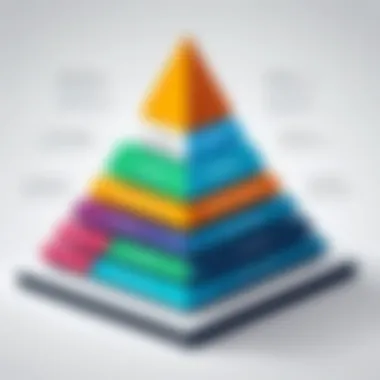Top Software Tools for Crafting Org Charts Effectively


Intro
Creating organizational charts is a necessary task for organizations of all sizes. These visual tools help to depict a company's structure, clarify roles, and enhance communication. This article assembles a compelling overview of various software solutions specifically designed for this purpose. By assessing key features, usability, and user needs, we aim to guide business professionals and decision-makers in selecting the best tool for their needs.
Key Software Features
Essential functionalities
When evaluating software for creating organizational charts, certain functionalities become paramount. First and foremost, a user-friendly interface is crucial. Dragging and dropping elements should be intuitive, allowing rapid adjustments without a steep learning curve. The best products, like Lucidchart or Microsoft Visio, offer templates that require minimal customization yet still maintain visual appeal.
Collaboration features are also significant for teams working on organizational design. Software that supports real-time collaboration ensures that stakeholders can contribute from various locations. Furthermore, export options for different formats such as PDF or SVG are essential for sharing charts across platforms.
Advanced capabilities
Beyond basic functionalities, advanced features enhance the effectiveness of organizational chart software. Integration with existing tools, such as HR systems, project management apps, or cloud storage, is a key consideration. Software that can sync with other platforms eases the workflow and reduces redundancy.
Additionally, some software allows for data-driven charts, pulling information from databases to automatically update the organizational structure. This is particularly important for large organizations that undergo frequent changes.
Comparison Metrics
Cost analysis
When contemplating software options, cost is always a consideration. Pricing varies significantly between platforms. For instance, Lucidchart offers a tiered pricing model, which can accommodate various budget levels. Meanwhile, free options exist, such as Draw.io, but may lack essential features. Evaluating these costs against the benefits provided is necessary for making an informed decision.
Performance benchmarks
Performance metrics are equally vital to assess. Response time, loading speed, and customer support are noteworthy aspects. Some software receives higher user ratings for efficiency and ease of use. Researching user feedback on platforms like Reddit can provide insights into how effective the software is in real-world scenarios.
"Choosing the right org chart software not only eliminates confusion but also empowers teams with clear structural visibility."
In summary, it is important to carefully navigate the features and costs of organizational chart software available today. Keeping the needs of decision-makers and IT professionals in mind will ensure the selection of a product that fosters clarity and supports organizational goals.
Preface to Org Chart Software
The role of organizational chart software is crucial in today's businesses. As companies grow, the complexity of their structures often increases. Understanding this complexity through visual representation simplifies communication among team members and helps in decision-making. Org charts clarify roles and responsibilities, allowing employees to visualize their place within the organization.
Championing a streamlined workflow, efficient org chart software integrates various functions like communication, project management, and human resources. With the correct tools, organizations can adapt quickly to changes, manage teams better, and maintain clarity in hierarchical relationships.
Defining Organizational Charts
An organizational chart is a visual representation of a company's structure. It illustrates the relationships and relative ranks of its parts and positions. Org charts can take many forms, including hierarchical, matrix, and flat formats. Each format serves a different purpose and is tailored based on the company's unique needs.
For instance, a hierarchical chart clearly delineates levels of authority, making it easier to identify who reports to whom. Conversely, a matrix chart offers flexibility and supports collaboration across departments, showing various reporting relationships.
Overall, defining organizational charts involves understanding the specific requirements of a business. This helps in creating a useful and meaningful chart that reflects the company's operational strategy.
Importance of Visualization in Business
Visualization is critical in business. It promotes better understanding and retention of information. Specifically, organizational charts enable employees to grasp the structure of the company quickly.
Effective org charts lead to:
- Improved Communication: Everyone can see who is responsible for what, facilitating better coordination.
- Clarity in Roles: Employees can more readily understand their responsibilities and those of their colleagues.
- Enhanced Decision-Making: Decision-makers can use visual structures to analyze relationships and workflows dynamically.
"Visual aids like org charts are invaluable in navigating complex structures efficiently."
In summary, org chart software provides integral support in portraying organizational structures clearly. This ultimately enhances performance and engagement across the entire organization.
Criteria for Selecting Org Chart Software


Selecting the right software for creating organizational charts is a critical decision for businesses. Organizational charts communicate structure and relationships within a company. Therefore, it is essential to assess various criteria when choosing the most suitable software. This selection process ensures that the tool aligns with the organization’s size, complexity, and future goals.
User Interface and Usability
When evaluating org chart software, the user interface and overall usability play a pivotal role. A clean, intuitive interface allows users to navigate the tool without difficulty. Complex features buried beneath layers of menus can frustrate users, especially those who may not be tech-savvy. Furthermore, a visually appealing design enhances user engagement. Users should be able to create charts quickly without extensive training. This efficiency leads to faster decision-making and better communication of information. Therefore, the importance of a seamless user experience cannot be overstated.
Integration Capabilities
In today's interconnected world, integration capabilities are increasingly vital. The ability to connect seamlessly with existing systems, such as Human Resource Management software and project management tools, is a critical factor in selecting org chart software. This capability saves time and reduces the chances of data inconsistency. For example, integrating with systems like Slack or Microsoft Teams can enhance communication by allowing easy sharing of updated charts. As businesses continue to rely on various software tools, ensuring compatibility becomes essential to avoid operational silos and enhance productivity.
Cost Considerations
Cost is an unavoidable factor in decision-making. Organizations must analyze the pricing structure of org chart software solutions. Some software offers different pricing tiers based on features or number of users. It is crucial to consider not just the initial costs, but also any ongoing fees for updates or additional support. Additionally, a free trial can offer insight into whether the software meets the organization's needs. Budget constraints are real, and understanding the value for money is vital for selecting a software solution that does not compromise quality while remaining financially feasible.
Customization Options
Another important aspect is the customization options available within the org chart software. Different organizations have unique structures requiring tailored charts to convey information effectively. Customizable templates, colors, and layouts help in aligning the org charts with the company’s branding. Furthermore, the ability to add specific roles or titles unique to the organization enhances clarity and relevance in representation. A rigid tool that does not allow for customization may lead to miscommunication or confusion within the team.
Top Software Solutions for Creating Org Charts
Choosing the right software for creating organizational charts is essential for effective business communication. A well-designed org chart helps visualize relationships, roles, and responsibilities within an organization. This visualization fosters clarity and aids decision-making among professionals and stakeholders. The tools available today offer various features tailored to different needs and preferences, so understanding their capabilities is critical.
Lucidchart
Key Features
Lucidchart stands out due to its user-friendly interface and powerful drawing tools. Its drag-and-drop functionality makes creating org charts easy and intuitive. The ability to export in multiple formats enhances its usability. Lucidchart supports real-time collaboration, an essential feature for teams working remotely. This characteristic sets it apart as a preferred choice in many organizations.
Pricing Structure
The pricing structure of Lucidchart includes a free tier with basic functionalities. Paid plans offer advanced features like team collaboration and integration with other applications. This tiered pricing caters to both individuals and organizations, making it accessible to small teams and larger enterprises alike. While the cost may increase with additional features, the value gained justifies the expense.
User Feedback
Users often commend Lucidchart for its ease of use and versatility. Positive feedback highlights the ability to create complex charts without a steep learning curve. Users appreciate integration with tools like Google Drive. On the other hand, some feedback points to limitations in the free version. Overall, it remains a popular choice due to its robust features.
Microsoft Visio
Key Features
Microsoft Visio is known for its professional-quality diagrams and templates. Key features include built-in shapes and icons geared toward creating detailed org charts. The advanced customization options allow users to tailor charts to their specific organizational structure. This flexibility is a main draw for larger companies with complex hierarchies.
Integration with Microsoft Products
Visio's ability to integrate seamlessly with Microsoft products is a key advantage. It works smoothly with Microsoft Office, enhancing productivity for users accustomed to Microsoft environments. This integration allows for easy data import from sources like Excel, simplifying the chart creation process. However, this focus on Microsoft may create challenges for those using alternative ecosystems.
User Feedback
Feedback on Microsoft Visio is generally positive, particularly among users familiar with the Microsoft ecosystem. Users value its comprehensive feature set and professionalism. There are concerns regarding its pricing, which some consider steep compared to alternatives. Despite this, many professionals find it a vital tool for their documentation needs.
SmartDraw
Key Features
SmartDraw is appreciated for its extensive library of templates and symbols. This ensures users can find the right visuals for their org charts quickly. Features like automatic formatting help maintain a polished look. SmartDraw's ease in creating complex diagrams can be a significant benefit for visual learners.
Cloud Capabilities
SmartDraw offers robust cloud capabilities, allowing users to access and edit diagrams from anywhere. This feature supports real-time collaboration, making it suitable for teams spread out geographically. However, some users note that these capabilities can be limited by internet connectivity. Overall, its cloud features enhance teamwork and accessibility.


User Feedback
Users praise SmartDraw for its intuitive design and comprehensive features. Feedback indicates that it can be ideal for large projects requiring detailed charts. Some critics mention that it can be cumbersome for simpler tasks, leading to a potential learning curve. Yet, its powerful toolset often outweighs initial disadvantages.
Creately
Key Features
Creately's main appeal lies in its affordability and ease of use. The pre-made templates simplify the process, allowing users to focus on content rather than design. It also features a mobile app, which adds to its flexibility. Creately's versatility makes it an attractive option for smaller businesses or teams with limited budgets.
Collaboration Tools
Creately emphasizes collaboration, providing features that allow team members to work together easily. Users can leave comments directly on the diagrams, facilitating communication and feedback. These tools can enhance team engagement and productivity, making Collaboratively easier than traditional methods.
User Feedback
The user feedback for Creately generally highlights its user-friendly nature and price-effectiveness. However, there are occasional complaints regarding its speed and responsiveness. Despite these concerns, many appreciate the ease with which they can produce effective org charts.
Gliffy
Key Features
Gliffy offers a simple platform that is easy to navigate. Its drag-and-drop editor allows rapid creation and modification of diagrams. Users appreciate the ability to integrate with various project management tools, making it suitable for teams that prioritize seamless workflows. Gliffy's integration capabilities with applications like Jira and Confluence enhance its utility in tech-oriented environments.
Integration Options
With Gliffy, integration options are broad, allowing for smooth incorporation into existing workflows. This is particularly beneficial for software development teams. Easy access to diagrams through these integrated tools ensures that project stakeholders are always informed. However, its dependency on integrations may lead to complications if users depend solely on the standalone functionality.
User Feedback
Users commend Gliffy for its simplicity and straightforward design process. Many point to its effective collaborative features as a highlight. However, some feedback notes limitations in advanced features compared to competitors. Despite some areas for improvement, it remains a favorable choice for teams needing basic functionalities with integration support.
Comparative Analysis of Org Chart Software
A comparative analysis of org chart software is essential for organizations aiming to optimize their internal structures. With various options available in the market, a methodical comparison offers clarity. This section breaks down key elements, such as features, pricing, and user experience. Understanding these aspects helps decision-makers choose the right tool tailored to their organizational needs.
Feature Comparison
When selecting org chart software, features play a pivotal role. Each software solution offers unique functionalities that cater to different user requirements. Some users may prioritize advanced visualization tools, while others might need robust integration capabilities.
- Visualization Tools: Key features include different chart styles, customizable templates, and drag-and-drop functionality. Lucidchart, for instance, excels with its vast array of chart styles.
- Collaboration Features: Real-time collaboration is vital for many teams. Tools like Creately allow multiple users to work on the same chart simultaneously.
- Integration Options: Seamless integration with existing tools, such as Slack or Google Drive, can enhance workflow. Software like Microsoft Visio provides excellent integration with other Microsoft Office products.
Through a feature comparison, users can align their specific needs with what each software offers, allowing for informed decisions.
Pricing Comparison
Cost is often a decisive factor in the selection of software. Understanding the pricing structure can prevent unexpected expenses later on. Most org chart software offers subscription models, but pricing can vary significantly based on features and user count.
- Free Trials and Free Versions: Some tools like Gliffy provide free versions with limited features. This can be beneficial for smaller teams or those just starting.
- Monthly vs Annual Pricing: Companies should consider whether they prefer monthly subscriptions or annual commitments. Annual plans often come with discounts, making them a more economical choice in the long run.
- Enterprise Solutions: For larger organizations, it may be necessary to evaluate the enterprise options. These often include superior functionalities and comprehensive support.
A careful pricing comparison ensures that organizations choose software that fits their budget while meeting their operational needs.
User Experience Comparison
User experience determines how effectively teams can adopt and utilize the software. A complicated interface can hinder productivity, while intuitive designs encourage user engagement.
- Ease of Use: Software like SmartDraw is known for its straightforward interface, making it accessible for both novices and experienced users.
- Support and Resources: Comprehensive support channels, such as chat assistance and community forums, enhance user experience. For instance, Lucidchart offers extensive online resources, guiding users through various functionalities.
- Feedback Mechanisms: Monitoring actual user feedback is crucial. Platforms often include reviews and ratings that reflect real-world experiences, helping users gauge effectiveness.
In summary, a comparative analysis of org chart software is critical. It emphasizes the need to evaluate features, pricing, and user experience when making a selection. This systematic approach enables organizations to choose the most effective tool, ensuring clear organizational structures that promote efficiency.


Best Practices for Creating Effective Org Charts
Creating effective org charts is essential for any organization seeking clarity and efficiency in its structure. This section discusses key practices that help ensure the org charts are not only visually appealing but also functional. By adhering to these best practices, organizations will benefit from improved communication, better decision-making, and ease in management. Let’s explore each of the practices that contribute to creating effective org charts.
Clear Hierarchy Representation
A fundamental aspect of an organizational chart is its ability to clearly represent the hierarchy within a company. Without a clear hierarchy, team members may feel confused about their roles and the reporting structure. When creating an org chart, it is important to use shapes and lines consistently to connect different positions. For example, a manager should appear above their direct reports, with clear lines indicating authority and responsibility. This clarity helps employees understand their place within the organization.
Additionally, color-coding roles can further enhance understanding. For instance, using one color for management positions and another for staff roles can make it easy to identify where each person fits within the org structure. This practice not only aids in visual comprehension but also helps in retaining crucial information about team relationships.
Consistent Formatting
Consistency in formatting is crucial for the readability of an org chart. When different styles or fonts are used randomly, the viewer may struggle to interpret the information presented. Choose a clean, simple font and stick with it throughout the chart.
Moreover, alignment plays an important role as well. Ensure all shapes are aligned properly, either centered or left-justified, depending on your preference. This will promote a professional appearance and increase the ease of understanding.
• Use universal symbols. Standard shapes help to convey a common understanding among viewers. • Maintain uniform spacing. Equal spacing between elements creates a clean layout and aids navigation.
Regular Updates and Maintenance
An org chart is not a static document; it should evolve with the organization. Regular updates are essential to reflect changes such as promotions, departmental shifts, or new hires. An outdated org chart can cause confusion and miscommunication within the company.
Set a routine for reviewing and updating the org chart, perhaps on a quarterly or biannual basis. Furthermore, encourage feedback from employees regarding the accuracy of the chart, as they may have insights into recent changes not yet documented.
Regularly revising your org chart ensures it remains a reliable resource for employees, reflecting the current structure and governance.
Future Trends in Org Chart Software
Understanding future trends in organizational chart software is critical for businesses aiming to stay ahead in a competitive landscape. As companies continue to evolve, so do their needs for effective visualization tools. Emerging technologies and user expectations shape the development of these software solutions. The integration of artificial intelligence and enhanced collaboration features represent two significant trends that hold the potential to redefine how organizations structure their workflows and communication.
Integration with Artificial Intelligence
The integration of artificial intelligence into org chart software is not just a futuristic concept. It is a present-day necessity. AI can enhance the functionality of these tools dramatically. For instance, AI can analyze employee data to automatically suggest the most effective structures for teams, making the design process simpler for users.
Benefits of AI integration include:
- Automated Updates: Artificial intelligence can track changes in the organization. If someone moves to a new position, the software can adjust the org chart automatically.
- Predictive Analytics: AI can analyze past organizational changes to forecast future staffing needs. This helps in planning for growth or restructuring.
- Enhanced User Insights: By evaluating user interactions with the software, AI can provide recommendations tailored to specific team needs.
This trend also presents considerations. Organizations must focus on data privacy and ensure that AI-driven tools maintain the security of sensitive information. Furthermore, while the promise of AI is considerable, firms should be prepared for the potential challenges of implementation and user training.
Increased Collaboration Features
The demand for increased collaboration features in org chart software reflects a shift towards more interconnected workplaces. Collaborating effectively is the key to productivity in any organization. As teams become more virtual and diverse, the need for tools that facilitate seamless communication and teamwork is ever-increasing.
Enhanced collaboration enables decision-makers to:
- Share Ideas in Real-Time: With improved sharing options, users can edit charts simultaneously, allowing for a dynamic development process.
- Gather Feedback Easily: Integrated commenting and feedback tools make it easy for team members to contribute their thoughts directly on the chart.
- Utilize Cloud Solutions: As the remote work model persists, cloud-based org chart tools allow team members to access and update charts from anywhere, thus increasing flexibility.
Closure
In this article, we explored the landscape of org chart software, shedding light on the crucial elements that decision-makers need to consider. The conclusion serves as a pivotal part of the narrative, offering a synthesis of the insights gathered throughout the discussion.
Recap of Key Insights
We began by defining organizational charts, emphasizing their role in visually mapping organizational structure. This understanding set the foundation for identifying essential criteria when selecting org chart software. Key aspects such as user interface, integration capabilities, cost considerations, and customization options were thoroughly examined.
The analysis of top software solutions, including Lucidchart, Microsoft Visio, and SmartDraw, provided clarity on features that cater to different user needs. By comparing their functionalities, pricing structures, and user feedback, the article highlighted which software can best meet specific organizational requirements. This comparative analysis underscores the multifaceted nature of these tools, revealing that there is no one-size-fits-all solution.
Making an Informed Choice
The decision to select org chart software is not merely a technical choice; it is a strategic move that can influence clarity and efficiency within a business. When making this decision, it is vital to prioritize functionalities that align with the organization’s goals. Consider the ease of use for team members and how the software integrates with existing tools. Cost is always a factor, but a higher price does not always equate to better service.
Incorporating user feedback can also guide the decision-making process. Real-world experiences often reveal the strength and weaknesses of the software. Therefore, practical insights can lead to more informed choices.
Ultimately, the final decision should involve careful deliberation of the insights presented in this article. The importance of regularly updating the org chart to reflect organizational changes cannot be overstated.
By taking these considerations into account, businesses can adopt org chart software that not only enhances visualization but also fosters improved communication within teams.



